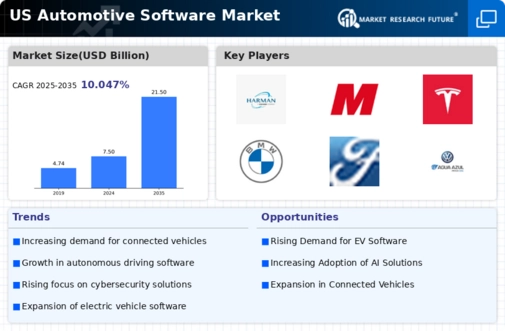The US Automotive Software Market is witnessing dynamic growth driven by the increasing demand for advanced technology in vehicles, emphasizing connectivity, safety, and driver assistance features. This market is becoming increasingly competitive as traditional automotive manufacturers and tech companies alike innovate and enhance their software capabilities to meet consumer expectations and regulatory standards. Key players are focusing on software solutions that integrate with hardware systems to create seamless user experiences.
The competitive landscape is characterized by strategic partnerships, the development of proprietary technologies, and significant investments in research and development to stay ahead of rapidly evolving trends. As automotive manufacturers transition toward electric and autonomous vehicles, the implications for software systems will become ever more critical, influencing the competitive positioning of various companies.Toyota Motor Corporation has established itself as a formidable presence within the US Automotive Software Market, leveraging its extensive experience in the automotive sector and commitment to innovation.
The company has made impressive strides in integrating software solutions with its vehicles, focusing primarily on enhancing safety, connectivity, and environmental standards. Toyota’s strengths lie in its robust brand reputation, widespread consumer trust, and commitment to quality, which all contribute to its competitive edge in introducing software-driven technologies. Moreover, Toyota continues to invest in next-generation technological advancements, including collaborative initiatives with tech firms to develop advanced driver-assistance systems and infotainment solutions tailored for the US market.
This dedication to evolving software offerings positions Toyota favorably in a competitive landscape that prioritizes technology-led advancements.Harman International, a subsidiary of a multinational technology company, is strategically enhancing its role in the US Automotive Software Market with a strong portfolio of software solutions that enhance vehicle connectivity and infotainment experiences. The company has carved out a significant niche by offering innovative products and services, including advanced audio systems, connected car platforms, and user interface technologies that cater specifically to the needs of the automotive sector.
Harman International's strengths stem from its ability to leverage cutting-edge technology and consumer insights to develop tailored software solutions, enabling partners to deliver enhanced in-car experiences. Additionally, Harman has engaged in various mergers and acquisitions to strengthen its market presence and accelerate the development of new automotive technologies. This proactive approach to innovation and collaboration underlines the company's commitment to remaining at the forefront of the automotive software landscape in the US, responding to both consumer demand and industry shifts toward electrification and connectivity.



















